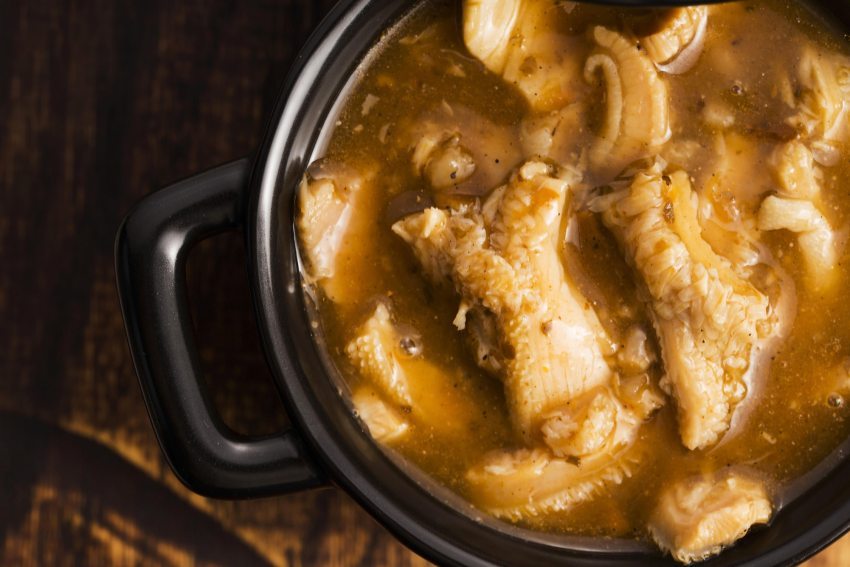Lung strudel and stuffed bovine spleen – Bizarre dishes from old cookbooks
At first glance, some of the dishes in our old cookbooks may seem bizarre. Stuffed bovine spleen rotisserie. A lamb-brain sandwich with green herbs and ginger. Roast cow's udder in tarragon. Veal liver with sour cream and lemon. Stew with chicken blood. Looking at the list we can conclude that our ancestors were not picky at all. But were they really the weird ones?

Why would they have been? Once the animal had been killed, there was no question of eating every bits and pieces of it and thus putting it to good use. Thinking of it, that is what gives its death, and life, meaning. This old perception is a far cry from today's practice, which, in the spirit of industrial-scale food production, sees the animal only as a commodity to be placed on the refrigerator shelf, often only as a sought-after fillet. Therefore, it does not matter if the turkey cannot walk from its unnaturally enlarged breast; if the pig cannot even get up from its abnormal weight throughout its whole life, and so some part of its body is always covered with boils; if the chicken never sees the light of day because it is forced to end its short life in a huge building. If you think about it for a moment, maybe it's not the old food that's strange.
From ears to tails
"Cut the ear and the tail to the length of a finger and boil it, add vegetables, carrots, bay leaves, ground pepper, and vinegar, drain and put the meat in the bowl, strain the juice and serve with grated horseradish" - wrote Aunt Rézi, a cook from Szeged (Southern Hungary) in 1876 in a recipe on pigs. They also served the pig's ears and tail "baked in their own robe": they sprinkled paprika on onions fried in fat, threw the chopped meat on top and roasted it until tender. Meanwhile, potatoes were boiled, peeled, and then mashed. Finally, they greased a baking tin, spread a finger and a half of mashed potatoes on it, spread the paprika on the meat, covered it with potatoes, and baked it until red. It was delicious with homemade pickles.
Tongues
Although tongues are still eaten today, mostly as a cold cut, the tongue meat served in a lemon and butter sauce is less well-known. According to a recipe from 1601 from Késmárk (now Kezmarok, Slovakia), it was popular, stuffed with boiled eggs, bacon, parsley, saffron, salt, and pepper, then rolled up and roasted on skewers. But we don't have to go back that far in our culinary history! In the 1930s, Elek Magyar left us recipes that are still usable today. He used to pre-boil the beef tongue in salted water, then stuff it with minced meat, eggs, parsley, lemon zest, and capers, bake it brown in butter and serve it with a lemon or caper sauce. The veal or sheep tongues, after having been precooked, were stewed with tomatoes and served with macaroni.
And as for the cold cuts, János Bittner wrote about black tongue cheese in his book Finom hentesáruk ('Charcuterie'), published in 1909, which was interesting because the cheese was blackened with blood (which also served as a thickening) and seasoned with cinnamon and white pepper.
Offal
The liver and kidneys are among the less overlooked offal. Of course, they are also found in old cookbooks, for example, roasted on skewers. Both were served with vinegar and garlic base. Lungs are less common nowadays, but they are also very easy to prepare. "It should be in a thick broth so that you can eat it with a spoon because that's the first secret of the offal. The second secret is to cut the lungs into small slices, the size of a fingernail because that’s how you make it tender. The third secret is to add not just a spoonful of lemon, as in modern restaurants, but a lemon cut in half," Krúdy wrote of the classic dish. Lungs were also popular as a soup garnish: eggs were added to the chopped offal, fried in fat, and stuffed into a paste. It was cooked in the soup. Just like lung strudel. According to Elek Magyar, this was made by mixing pre-cooked, finely chopped lungs with buns soaked in milk, fried onions, sour cream, salt, and pepper, and then this mixture was stuffed into a strudel. And then served with hot vegetable soup.
And so on…
The only time we eat blood (roast, with onions) is at a pig slaughter. However, in traditional Hungarian cuisine, this is one of the oldest materials used for thickening. In the 16th century Cook's Science, we read that it was used, for example, to make a sauce for sheep-testicle stew. The testicle should be "thrown into the fire and its strong skin will flake off. Clean it well in water, draw the skin off, wilt it, and make a black broth of hen's blood for it. Pour cow's-meat soup and vinegar on it. Put bread, apples, pepper, and saffron in it, and let it boil in the black soup," says the five-hundred-year-old recipe. The description of 'stuffed sheep's stomach' is just as old. For this, other parts of the animal, along with the blood, salt, and pepper were stuffed into the stomach and then cooked in vinegar and horseradish soup. Lentils and bacon could also be added. A cow's udder was also a fine dish. It had to be boiled in salted water until tender before being rolled in flour and fried in hot fat. According to Aunt Rézi, 'it can be served with a broth or sour cream sauce and garnished with lemon slices'. It was also served with sauerkraut - for this version, thyme and basil were used as spices. In the 17th century, it was fried with bacon and served with a cinnamon-allspice sauce. The list of ingredients, once all unobjectionable, goes on and on. They (also) contributed to the variety and richness of our cuisine.







